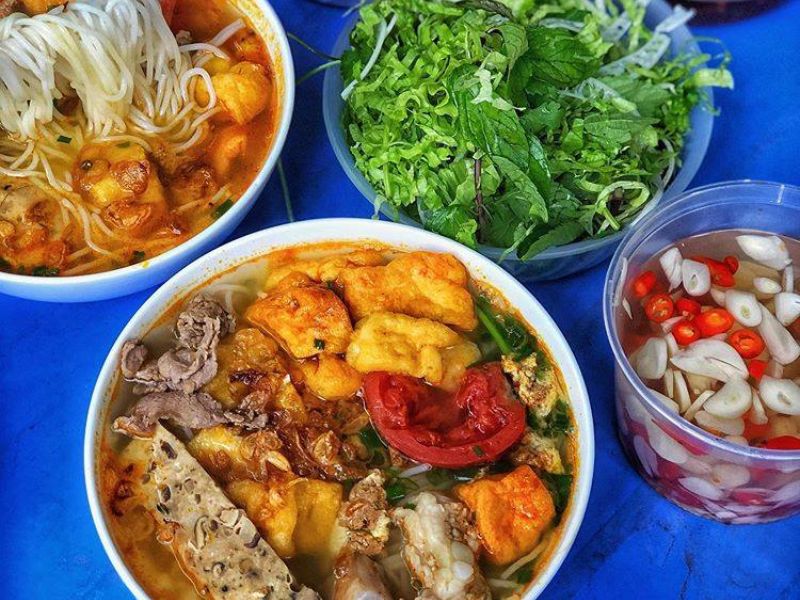
Traditional bun rieu cua: A Nostalgic Delight in the Heart of Hanoi
- on Dec 2, 2024 By: Phuong Mai NGUYEN
Hardly have we come across any fine literary pages devoted to Bún riêu cua (Vietnamese crab noodle soup) in the writings of the fine gourmets of yesteryear, such as Thach Lam or Vu Bang, who so poetically celebrated phở, bánh cuốn or even bún thang. Yet, although somewhat overshadowed by its more famous cousins, this dish has now established itself as one of Hanoi's most cherished delicacies.
The popularity of Bun rieu cua is vividly proved during the Vietnamese New Year when it becomes a sought-after treat for lovers of authentic flavors. On this special occasion, bowls of the savory soup are sold at premium prices—reaching several hundred thousand dong per serving—without dampening the enthusiasm of its loyal and ever-growing clientele.
Discover why Vietnamese crab noodle soup has become a must-try dish for anyone exploring Hanoi’s rich culinary heritage.
Hanoi's Authentic Bún riêu cua
Bún riêu cuais a traditional Vietnamese dish from the Red River Delta, where freshwater crabs abound in the rice paddies. This time-honored specialty is integral to Northern Vietnamese cuisine and continues to captivate local and international palates.
Hanoi’s crab noodle soup is distinguished by its vibrant orange color broth, owing to the coarsely chopped crab, and by its characteristic tangy taste, achieved thanks to dấm bỗng (rice vinegar) and tomatoes. Crafting the perfect broth is a true art form. It begins with the careful selection of crabs, which are weighed and finely ground to extract their essence. The straining process reveals a clear, vibrant stock, brimming with potential. The addition of rice vinegar is a crucial moment that harmonizes the flavors and elevates the dish to new heights. Each Vietnamese crab noodle soup vendor passionately guards their unique recipe, as these closely held secrets are the lifeblood that nurtures their loyal customers. Every bowl has a story, a tradition, and a commitment to excellence that inspires all who experience it.
This dish is usually enjoyed with an assortment of fresh vegetables like sliced banana blossoms, lettuce, basil, and uniquely prepared water spinach stems. A touch of mắm tôm (fermented shrimp paste) further enhances the taste of this already flavor-rich dish.
Each bowl of Vietnamese crab noodle soup is a vibrant feast for the senses, featuring the bright orange of the crab, the green of the spring onions, and the red of the tomatoes. This dish is complemented by fried tofu and a touch of fermented shrimp paste, creating a delightful visual and flavorful experience. A bowl of bun rieu cua can not be complete without a side plate of fresh herbs and vegetables. Sliced banana blossoms and julienned water spinach stems are essential for fully savoring this authentic Vietnamese delicacy.
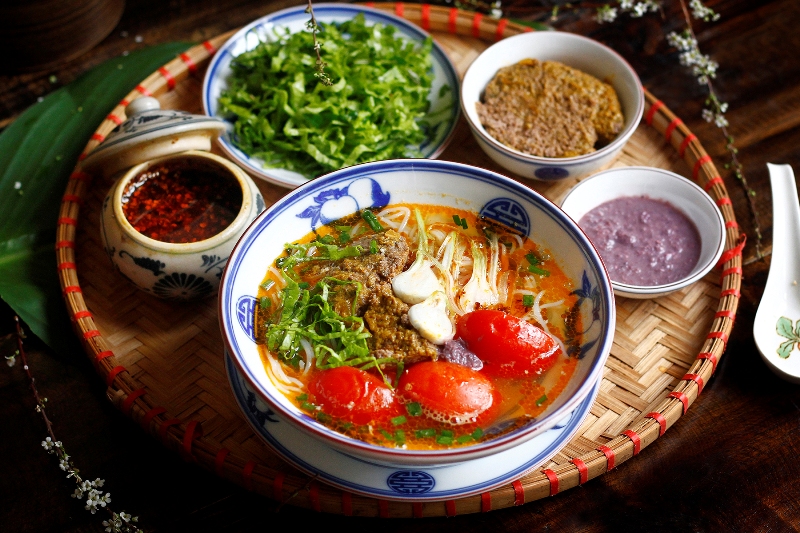
Memories of a Hanoi of yesteryear: The Original Bún Riêu Cua
It is hard to resist the tantalizing smell of Crab noodle soup wafting from one of the small stalls where steam billows from a bubbling stock pot. Whether it's hot or cold, this dish, enjoyed all year round, is a staple of local cuisine. On scorching summer days, bún riêu cua, with its tangy, refreshing taste, offers a soothing break. But even in winter, its enveloping warmth and subtle taste warm the heart.
The bún riêu cua from Hanoi is famous for its clear broth, made from local freshwater crabs. Traditionally, preparing this dish was a meticulous process. Vendors would carefully select crabs, grind them, and strain the mixture to create a delicate and aromatic stock. Fresh tomato wedges were added to enhance the fragrance, infusing the broth with a subtle, inviting aroma. The use of traditional rice vinegar (dấm bỗng in Vietnamese) balanced the flavors of the broth with a gentle sourness while preserving the pure taste of the crab.
While recipes have evolved over the years, the essence of this noodle soup remains unchanged. The original version of this dish consisted only of rice noodles, crab broth, and pieces of fried tofu, which made it particularly popular with Hanoi residents, who appreciated its simplicity and lightness.
In the 1980s, during Vietnam’s food shortage, bún riêu cua was a practical and affordable solution. At a time when meat was scarce and expensive, crab was a more accessible resource. Vendors offered fresh crabs, often threaded onto bamboo stalks, hung, and transported to local markets. The spirit of the dish lay in the freshness of these crabs, chosen for their firm texture and delicate flavor. After thorough cleaning, the crabs were pounded to extract their juice and flesh, before being boiled until the “riêu” (minced crab) formed into small, distinct bites on the surface of the broth.
Traditional rice vinegar contributes as a secret to the dish’s success. The mildly alcohol taste of the vinegar blends perfectly with the crab’s aroma, neutralizing their strong scent, and creating a delicate balance, and richness of flavors.
Nowadays, bún riêu cua remains a humble dish and continues to reflect the soul of Hanoi’s cuisine: a celebration of simplicity, fresh ingredients, and meticulous attention to detail. With each bite, diners discover not only a unique flavor, but also a little piece of history, a testimony to Hanoi's past, and to the ingenuity of the local cooks who perpetuate this ancestral know-how.
The evolution of Vietnamese crab noodle: From humble beginnings to a world-renowned specialty
Today, this Vietnamese traditional noodle soup is enjoyed not only in Vietnam but also internationally, especially by Western travelers. As much as this dish is synonymous with authentic flavors, over the years, the dish has gone through several transformations, from a simple and modest dish to richer and more varied versions, adapted to modern tastes.
A reinvention of a simple dish
In the past, bún riêu cua was rather a simple dish, often served with river crab, tofu, and a pork-based broth, eaten mainly for breakfast as the simplicity and lightness made it an ideal way to start the day without feeling overly full. Over time, vendors have developed the recipe to meet the demands of more diverse palates. Today, the addition of many other ingredients including crab roe, pig’s trotters, pork ribs, and even beef has become common. This evolution has made the dish heartier and more sophisticated, shifting it from a "humble street food" status to one that appeals to diners seeking more intense and complex flavors.
International recognition
Recently, bún riêu cua was ranked among the "100 best-rated crustacean dishes" globally by the culinary platform Taste Atlas, earning an impressive score of 4.1/5. This international accolade highlights the dish's growing appeal among gourmets worldwide.
Whether you're a culinary adventurer or a casual food lover, savoring a bowl of bún riêu cua is not just about enjoying a meal—it's about experiencing a unique slice of Vietnam's vibrant food culture, rich history, and evolving tastes.
Regional Variations and Modern Influences of Bún Riêu
Bún riêu, the beloved Vietnamese crab noodle soup, boasts a variety of regional adaptations. In southern Vietnam, where river crabs are less commonly found, chefs have innovated with substitutes such as dried shrimp to create bún riêu tôm khô, a distinct and equally delectable version. In Ho Chi Minh City, a small neighborhood eatery with over 50 years of history serves this southern specialty, enriched with pork, fried tofu, and additional toppings like chả lụa (Vietnamese sausage) or chả quế (cinnamon-flavored pork sausage).
Praise from International food critics
Australian journalist and travel columnist Ben Groundwater recently lauded this Vietnamese dish in the Sydney Morning Herald. He described this noodle soup as a delightful harmony of delicate yet bold flavors, featuring pork, fried tofu, and fresh vegetables. Groundwater emphasized that while every region in Vietnam offers its unique spin on bún riêu, the core ingredients—crab, pork broth, and an assortment of flavorful garnishes—remain consistent, making it a comforting meal any time of the day.
The appeal of Vietnamese crab noodle soup has transcended Vietnam's borders, finding a home in Vietnamese restaurants around the world. In Australia, eateries like Phở Sông Hương in Bankstown (Sydney) and Bun Cha Co Dao in Footscray (Melbourne) present their interpretations of this iconic dish, catering to a growing audience of Asian cuisine enthusiasts.
In 2023, Max McFarlin, an American food blogger, also expressed his admiration for bún riêu tôm khô during a visit to Ho Chi Minh City. He particularly enjoyed the broth’s lightness, subtly infused with the flavor of dried shrimp, which he noted was a refreshing contrast to the heavier versions he had previously tasted in Hanoi.
Whether it's the robust flavors of the northern style or the lighter, shrimp-forward notes of the south, bún riêu continues to captivate locals and global food lovers alike, showcasing the diversity and creativity of Vietnamese cuisine.
Simple Recipe for Vietnamese Crab Noodle Soup at Home
Through the decades, Vietnamese crab noodle soup has evolved while retaining its soul, continuing to captivate locals and travelers with its simple yet rich flavors. Whether in Hanoi, Ho Chi Minh City, or on the other side of the world, this iconic Vietnamese dish remains a crowd-pleaser. Here’s an easy recipe to recreate this delicious dish at home.
Ingredients
300 g ground freshwater crab
1 kg fresh rice noodles
3 tomatoes
2 pieces of tofu
2 shallots
2–3 tbsp fermented shrimp paste (mắm tôm)
1 tbsp vegetable oil
1 tbsp lard (or pork fat)
Spices: Salt, sugar, bouillon powder, pepper
Fresh herbs: Watercress, bean sprouts, lettuce, perilla leaves, Vietnamese mint
Preparation
Step 1: Prepare the Crab
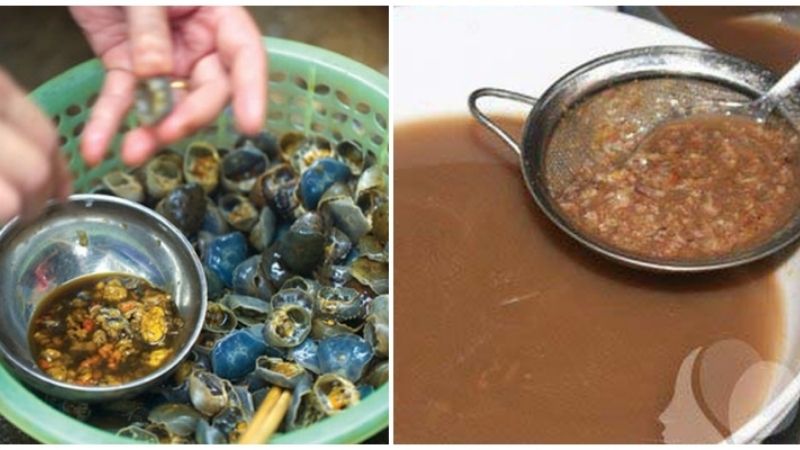
Soak the crabs in water for about an hour to remove any dirt and sand, then rinse thoroughly. Peel off the crab shell and set aside.
Grab your mortar and pestle. Put the crab in the mortar, add a pinch of salt, then pound with the pestle. Adding salt helps the protein in the crab meat to stick together better. Then, put the pounded crab in a pot, add 3 large bowls of water, and stir gently. Let it rest for about 15 minutes.
Strain the pounded crab, keeping the liquid, and removing any solid residues.
As for the crab shell, use a toothpick, a chopstick, or a small spoon to get the roe. Put the roe in a small bowl, and season with some ground pepper and salt.
Note:
If you can not find fresh freshwater crabs, you can use canned minced crab.
If you don't have a set of mortar and pestle, you can use any alternative. A food processor is a good alternative to grind the crabs.
Step 2: Prepare the broth
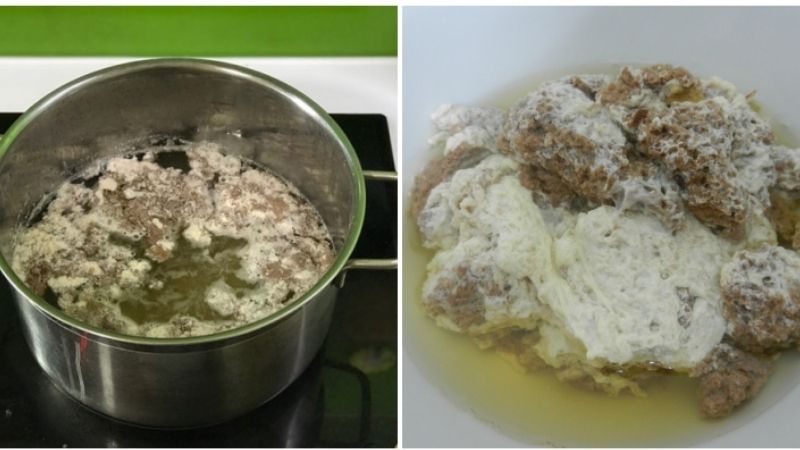
In a larger pot, add some vegetable oil and saute chopped shallots until golden. Add quartered tomatoes and cook until softened.
In the same pot, add the crab roe, and cook for about 2 minutes.
Pour the strained crab liquid into the pot. Season with fermented shrimp paste (mắm tôm), salt, and sugar. Bring the liquid to a boil over low heat to allow the crabmeat to solidify.
Stir in a beaten egg to slightly thicken the broth while gently mixing.
Step 3: Fry the tofu
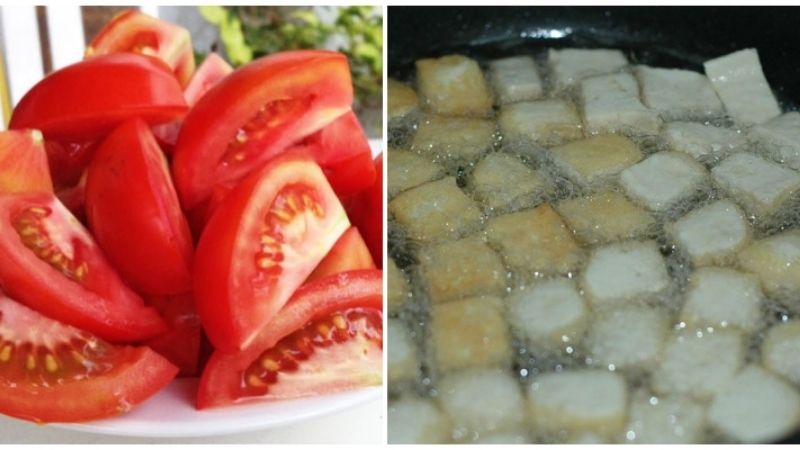
Cut tofu into small cubes and fry until golden and crispy.
Step 4: Prepare the Noodles and Fresh Vegetables
Briefly blanch the rice noodles in boiling water, drain, and set aside.
Thoroughly wash the fresh vegetables (water spinach, lettuce, bean sprouts, perilla, Vietnamese mint) and let them drain.
Step 5: Assemble the Dish
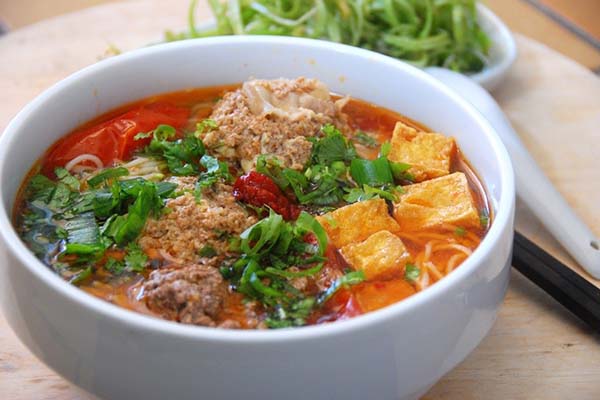
Place the noodles in a bowl, top with fried tofu, solidified crab meat, and generously ladle the hot broth over everything.
Garnish with fried shallots and aromatic herbs like perilla and Vietnamese mint for added fragrance.
Serve with fresh vegetables and a side of fermented shrimp paste or fish sauce with chili for extra flavor.
Tips:
When cooking the crab broth, stir gently to avoid breaking the clumped crab meat.
Use high-quality fermented shrimp paste and dilute it slightly before adding it to avoid overpowering saltiness.
Add the fresh vegetables to your liking or to match regional specialties.
TOLUNHA
Related articles:
>> Top Hanoi must-try dishes and best places to eat in Hanoi Old Quarter
 Español
Español Français
Français








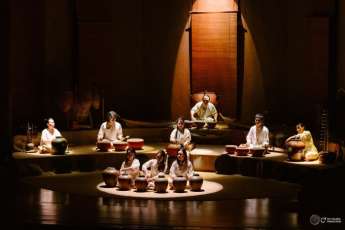

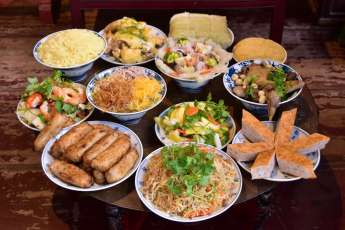
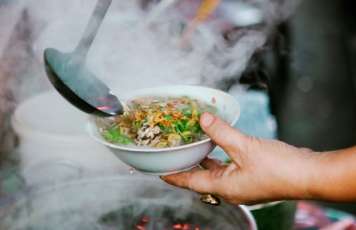
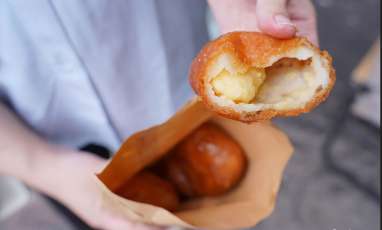







Morgane Ter Cock
on Dec 18, 2025HerbertPhomaMS
on Oct 19, 2025Lilyan Cuttler
on Oct 15, 2025Avenue17XC
on Sep 14, 2025Avenue18JL
on Jul 21, 2025